Important Formulae : Interests | Mathematics for RRB NTPC / ASM - RRB NTPC/ASM/CA/TA PDF Download
Introduction
In competitive exams, questions on Simple Interest (SI) and Compound Interest (CI) are common, as they assess basic mathematical skills and the ability to apply concepts of financial growth over time. These topics are fundamental in banking, finance, and investment sectors, making them essential for exams like SSC, RRB, UPSC, and banking exams.
Simple Interest Formulas
1. Simple Interest (SI)
SI = (P × R × T) / 100
Example : If a principal amount of ₹1,000 is invested at an interest rate of 10% per annum for 3 years
Principal (P) = ₹1000, Rate (R) = 10%, Time (T) = 3 years
SI = (1000 × 10 × 3) / 100 = 300
Simple Interest = ₹300
2. Total Amount (A)
A = P + SI
Example : From the above ques what will be the total amount
Simple Interest (SI) = ₹300, Principal (P) = ₹1000
A = 1000 + 300 = 1300
Total Amount = ₹1300
3. Principal (P)
P = (SI × 100) / (R × T)
Example : If the simple interest is ₹200, the rate of interest is 5% per annum, and the time is 4 years
Simple Interest (SI) = ₹200, Rate (R) = 5%, Time (T) = 4 years
P = (200 × 100) / (5 × 4) = 1000
Principal = ₹1000
4. Rate of Interest (R)
R = (SI × 100) / (P × T)
Example : If the simple interest is ₹300, the principal amount is ₹1500, and the time period is 2 years
Simple Interest (SI) = ₹300, Principal (P) = ₹1500, Time (T) = 2 years
R = (300 × 100) / (1500 × 2) = 10%
Rate of Interest = 10%
5. Time Period (T)
T = (SI × 100) / (P × R)
Example : If the simple interest is ₹600, the principal amount is ₹2000, and the rate of interest is 6%
Simple Interest (SI) = ₹600, Principal (P) = ₹2000, Rate (R) = 6%
T = (600 × 100) / (2000 × 6) = 5 years
Time Period = 5 years
6. Simple Interest for Fractional Time Period
SI = (P × R × T) / 100
Where T is in years (e.g., for 6 months, T = 0.5; for 45 days, T = 45/365).
Example : If ₹2,000 is invested at a 12% interest rate for 6 months:
Principal (P) = ₹2000, Rate (R) = 12%, Time (T) = 6 months = 0.5 years
SI = (2000 × 12 × 0.5) / 100 = 120
Simple Interest for 6 months = ₹120

Compound Interest Formulas
1. Compound Interest when Interest is Compounded Annually
A = P × (1 + R/100)^T
Where:
- A = Total amount
- P = Principal
- R = Rate of Interest per annum
- -T = Time period in years
Example : A sum of ₹5000 is invested at an annual interest rate of 8% for 2 years. Find the compound interest and the total amount at the end of 2 years.
Solution:
Principal (P) = ₹5000
Rate (R) = 8% per annum
Time (T) = 2 years
A = P × (1 + R/100)T
Substitute the values:
A = 5000 × (1 + 8/100)2 = 5000 × (1.08)2 = 5000 × 1.1664 = ₹5832
The total amount after 2 years = ₹5832
Compound Interest = ₹832
2. Compound Interest when Interest is Compounded Half-Yearly
A = P × (1 + R/(2 × 100))^(2 × T)
Example : A sum of ₹10000 is invested for 1 year at 12% per annum, compounded half-yearly. Find the compound interest and the total amount.
Solution:
Principal (P) = ₹10000
Rate (R) = 12% per annum (compounded half-yearly)
Time (T) = 1 year
A = P × (1 + R/2 × 100)2T
Substitute the values:
A = 10000 × (1 + 12/2 × 100)2×1 = 10000 × (1.06)2 = 10000 × 1.1236 = ₹11236
The total amount after 1 year = ₹11236
Compound Interest = ₹1236
3. Compound Interest when Interest is Compounded Quarterly
A = P × (1 + R/(4 × 100))^(4 × T)
Example : A sum of ₹2000 is invested at 10% per annum, compounded quarterly for 2 years. Find the compound interest and the total amount.
Solution:
Principal (P) = ₹2000
Rate (R) = 10% per annum (compounded quarterly)
Time (T) = 2 years
A = P × (1 + R/4 × 100)4T
Substitute the values:
A = 2000 × (1 + 10/4 × 100)4×2 = 2000 × (1.025)8 = 2000 × 1.21899 = ₹2437.98
The total amount after 2 years = ₹2437.98
Compound Interest = ₹437.98
4. Compound Interest when Time is Fractional :
A = P × (1 + R/100)^T
Where:
- T can be a fractional value such as 3 2/5
A = P × (1 + R/100)^3 * ( 1+ 2/5 R / 100 )
Compound Interest: C.I. = P ( 1 + r100 )t - P
Example :The compound interest on a certain sum at 10% p.a. for years is ₹ 1201.60, interest compounded yearly. The sum is
Solution
1201.60 = P ( 1 + 10100 )73 - P
Simplification: 1201.60 = P ( 1110 )2 ( 1110 )13 - P
Solution: 1201.60 = 1.25 P - P
P = 1201.600.25 = 4806.4 ≈ ₹ 4800Hence, the sum is ₹ 4800
5. Compound Interest when Rates Differ for Different Years
A = P × (1 + R1/100) × (1 + R2/100) × ... × (1 + Rn/100)
Where:
- R1, R2, ..., Rn = Rates of interest for each respective year.
Example : A sum of ₹12000 is invested for 3 years. The rate of interest is:
- 1st year: 6%
- 2nd year: 8%
- 3rd year: 10%
Calculate the compound interest and the total amount.
Solution:
Principal (P) = ₹12000
Rate for 1st year (R₁) = 6%
Rate for 2nd year (R₂) = 8%
Rate for 3rd year (R₃) = 10%
A = P × (1 + R₁/100) × (1 + R₂/100) × (1 + R₃/100)
Substitute the values:
A = 12000 × (1 + 6/100) × (1 + 8/100) × (1 + 10/100)
A = 12000 × 1.06 × 1.08 × 1.10 = 12000 × 1.254432 = ₹15053.18
The total amount after 3 years = ₹15053.18
Compound Interest = ₹3053.18
6. Present Worth of an Amount (x) due in ( n) Years
P resent worth= x / (1 + R/100)^T
|
146 videos|96 docs|98 tests
|

|
Explore Courses for RRB NTPC/ASM/CA/TA exam
|

|

















